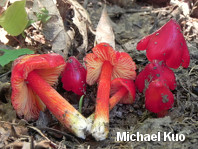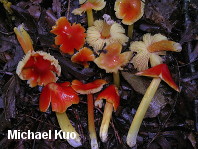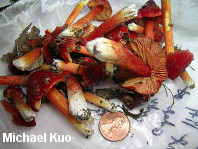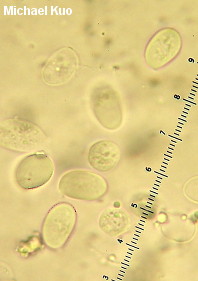| Major Groups > Gilled Mushrooms > Pale-Spored > Waxy Caps > Hygrocybe cuspidata |

|
Hygrocybe cuspidata [ Basidiomycota > Agaricales > Hygrocybaceae > Hygrocybe . . . ] by Michael Kuo This gorgeous waxy cap might best be described as a non-blackening version of Hygrocybe conica--or as a red version of the orange or yellow species Hygrocybe acutoconica. Its sharply pointed cap is scarlet red and sticky when fresh and young; its stem is dry, and ranges from reddish to yellow. According to some mycologists (e.g. Boertmann, 2000), Hygrocybe cuspidata should not be treated as distinct from Hygrocybe acutoconica, since it differs only in color. Smith and Hesler (1963) treated the mushrooms as distinct species. My collecting experience suggests the two should be maintained as separate species, particularly because I have seen the two fruiting in distinct red and orange groups, only a few meters apart, without any orange-red "intermediates" present (even though faded specimens of both groups were present). Some confusion over whether the name Hygrocybe cuspidata is validly applied to a non-blackening species exists, along with some confusion about the validity of the name; see the discussion below if you care. Hygrophorus cuspidatus is a synonym, as is Hygrocybe acutoconica var. cuspidata. Description: Ecology: Precise ecological role uncertain (see Lodge and collaborators, 2013); growing scattered or gregariously under oaks and other hardwoods; late spring through fall; apparently widely distributed in North America. The illustrated and described collections are from Illinois. Cap: 2-4 cm; conical, expanding to broadly conical; slimy to sticky when fresh; bald; scarlet red, fading to orangish red; the margin sometimes faintly lined, often upturned and splitting in age. Gills: Free from the stem or narrowly attached to it; close or almost distant; thick; pale orange or orangish yellow, darkening with age. Stem: 2.5-6.5 cm long; 0.5-2 cm thick; equal or slightly tapering to apex; dry, or a little tacky when handled; bald, becoming fibrillose with age; often becoming grooved and/or twisted lengthwise; becoming hollow; colored like the cap, or paler; white at the base. Flesh: Yellowish or whitish; thin; not blackening. Odor and Taste: Not distinctive. Chemical Reactions: KOH negative on cap surface. Spore Print: White. Microscopic Features: Spores 10-14 x 5-8 µ; smooth; ellipsoid or occasionally subcylindric; occasionally constricted; smooth; hyaline in KOH; inamyloid. Basidia 4-spored; to about 55 µ long. Hymenial cystidia absent. Lamellar trama parallel or nearly so. Pileipellis an ixocutis. REFERENCES: (Peck, 1897) Murrill, 1916. (Hesler and Smith, 1963; Smith, Smith & Weber, 1979; Largent, 1985; Boertmann, 2000; Roody, 2003; McNeil, 2006; Lodge et al., 2013; Kuo & Methven, 2014.) Herb. Kuo 05280401, 07120703, 06301103, 09261202. Peck's original description of Hygrophorus cuspidatus calls the cap "bright red," the gills "yellow," and says nothing about the color of the fresh stem. He compares it to Hygrocybe conica, saying it is skinnier and pointier than that species, and that its spores are more narrow. However, he says that "[a]s in that species the plants are apt to turn more or less black in drying." So the question arises: should Hygrocybe cuspidata be treated as a blackening species? Lodge and collaborators (2013, p. 27) appear to believe so. But others, including Smith and Hesler (1963, p. 135) have studied Peck's type collection and maintain Hygrocybe cuspidata as a non-blackening species: "[s]pecimens of this species do not blacken when bruised or dried." The fact that Peck did not mention any blackening in his description of the fresh material may indicate that he simply "cooked" the specimens in the drying process, causing a blackening unrelated to the kind of blackening found in Hygrocybe conica. I find this idea more plausible than the idea that Smith and Hesler studied the type collection but did not read the original description or discover this discrepancy--although I wish they had addressed the issue directly. Further confusion arises regarding the validity of the name Hygrocybe cuspidata. Peck described his species as a Hygrophorus, but it was combined into "Hydrocybe" (with a D) as "Hydrocybe cuspidata" by Murrill in 1916. Some sources, appear to recognize "Hydrocybe" as an orthographic variant of Hygrocybe, and do not question the validity of the combination Hygrocybe cuspidata. But other sources, including Lodge and collaborators (2013), cite the combination "Hygrocybe cuspidata (Peck) Roody," referring to Roody's 2003 Mushrooms of West Virginia and the Central Appalachians (which is a great field guide), in which Roody makes an illegitimate attempt at a new combination into Hygrocybe, neglecting, among other taxonomic rules, the need for a clear and direct reference to Peck's original publication. This website contains no information about the edibility or toxicity of mushrooms. |
© MushroomExpert.Com |
|
Cite this page as: Kuo, M. (2014, June). Hygrocybe cuspidata. Retrieved from the MushroomExpert.Com Web site: http://www.mushroomexpert.com/hygrocybe_cuspidata.html |



